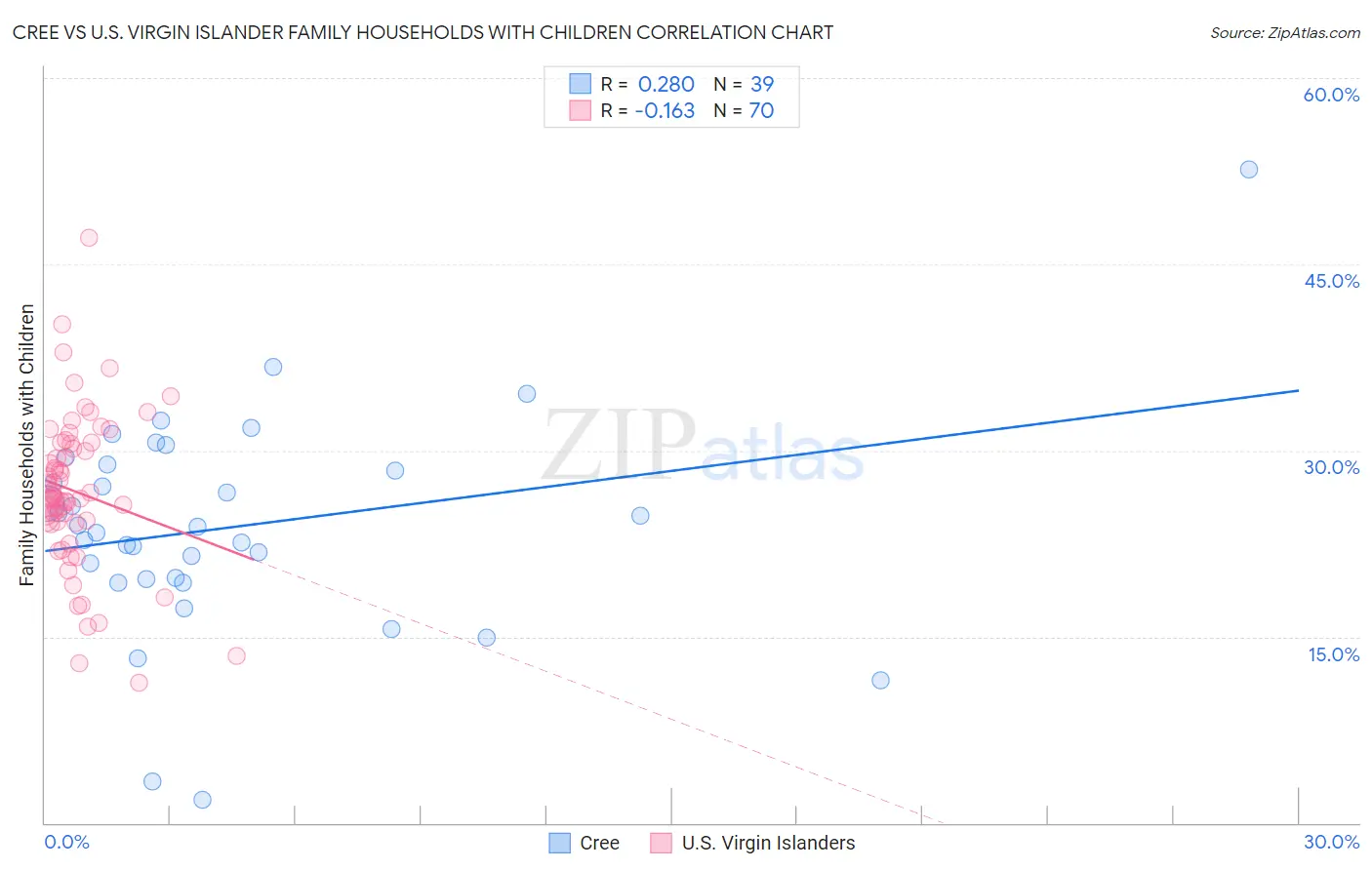Cree vs U.S. Virgin Islander Family Households with Children
COMPARE
Cree
U.S. Virgin Islander
Family Households with Children
Family Households with Children Comparison
Cree
U.S. Virgin Islanders
26.2%
FAMILY HOUSEHOLDS WITH CHILDREN
0.0/ 100
METRIC RATING
313th/ 347
METRIC RANK
27.1%
FAMILY HOUSEHOLDS WITH CHILDREN
12.1/ 100
METRIC RATING
217th/ 347
METRIC RANK
Cree vs U.S. Virgin Islander Family Households with Children Correlation Chart
The statistical analysis conducted on geographies consisting of 76,201,254 people shows a weak positive correlation between the proportion of Cree and percentage of family households with children in the United States with a correlation coefficient (R) of 0.280 and weighted average of 26.2%. Similarly, the statistical analysis conducted on geographies consisting of 87,501,464 people shows a poor negative correlation between the proportion of U.S. Virgin Islanders and percentage of family households with children in the United States with a correlation coefficient (R) of -0.163 and weighted average of 27.1%, a difference of 3.8%.

Family Households with Children Correlation Summary
| Measurement | Cree | U.S. Virgin Islander |
| Minimum | 1.9% | 11.3% |
| Maximum | 52.6% | 47.1% |
| Range | 50.7% | 35.8% |
| Mean | 23.9% | 26.7% |
| Median | 23.8% | 26.2% |
| Interquartile 25% (IQ1) | 19.6% | 24.3% |
| Interquartile 75% (IQ3) | 28.8% | 30.5% |
| Interquartile Range (IQR) | 9.2% | 6.3% |
| Standard Deviation (Sample) | 8.8% | 6.2% |
| Standard Deviation (Population) | 8.7% | 6.2% |
Similar Demographics by Family Households with Children
Demographics Similar to Cree by Family Households with Children
In terms of family households with children, the demographic groups most similar to Cree are French Canadian (26.1%, a difference of 0.080%), Immigrants from Norway (26.1%, a difference of 0.15%), Estonian (26.1%, a difference of 0.23%), Immigrants from Czechoslovakia (26.2%, a difference of 0.26%), and Colville (26.2%, a difference of 0.32%).
| Demographics | Rating | Rank | Family Households with Children |
| Bermudans | 0.1 /100 | #306 | Tragic 26.3% |
| West Indians | 0.0 /100 | #307 | Tragic 26.3% |
| Lumbee | 0.0 /100 | #308 | Tragic 26.3% |
| Immigrants | Somalia | 0.0 /100 | #309 | Tragic 26.3% |
| Marshallese | 0.0 /100 | #310 | Tragic 26.2% |
| Colville | 0.0 /100 | #311 | Tragic 26.2% |
| Immigrants | Czechoslovakia | 0.0 /100 | #312 | Tragic 26.2% |
| Cree | 0.0 /100 | #313 | Tragic 26.2% |
| French Canadians | 0.0 /100 | #314 | Tragic 26.1% |
| Immigrants | Norway | 0.0 /100 | #315 | Tragic 26.1% |
| Estonians | 0.0 /100 | #316 | Tragic 26.1% |
| Ottawa | 0.0 /100 | #317 | Tragic 26.1% |
| Iroquois | 0.0 /100 | #318 | Tragic 26.1% |
| Immigrants | France | 0.0 /100 | #319 | Tragic 26.0% |
| Tlingit-Haida | 0.0 /100 | #320 | Tragic 26.0% |
Demographics Similar to U.S. Virgin Islanders by Family Households with Children
In terms of family households with children, the demographic groups most similar to U.S. Virgin Islanders are Cuban (27.1%, a difference of 0.0%), Northern European (27.2%, a difference of 0.030%), African (27.2%, a difference of 0.040%), Greek (27.1%, a difference of 0.040%), and Immigrants from Dominica (27.2%, a difference of 0.080%).
| Demographics | Rating | Rank | Family Households with Children |
| Immigrants | Ukraine | 14.4 /100 | #210 | Poor 27.2% |
| Welsh | 14.2 /100 | #211 | Poor 27.2% |
| Immigrants | Dominica | 13.9 /100 | #212 | Poor 27.2% |
| Okinawans | 13.7 /100 | #213 | Poor 27.2% |
| Africans | 13.0 /100 | #214 | Poor 27.2% |
| Northern Europeans | 12.8 /100 | #215 | Poor 27.2% |
| Cubans | 12.2 /100 | #216 | Poor 27.1% |
| U.S. Virgin Islanders | 12.1 /100 | #217 | Poor 27.1% |
| Greeks | 11.4 /100 | #218 | Poor 27.1% |
| Immigrants | Japan | 10.7 /100 | #219 | Poor 27.1% |
| Austrians | 9.9 /100 | #220 | Tragic 27.1% |
| New Zealanders | 9.6 /100 | #221 | Tragic 27.1% |
| Paraguayans | 9.4 /100 | #222 | Tragic 27.1% |
| Pima | 9.2 /100 | #223 | Tragic 27.1% |
| Germans | 8.7 /100 | #224 | Tragic 27.1% |